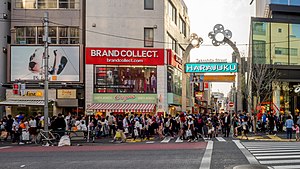Loading AI tools
Terrorist attack in Tokyo From Wikipedia, the free encyclopedia
The 2019 Tokyo car attack was a vehicle-ramming attack that occurred on January 1, 2019, in Tokyo, Japan. 21-year-old Kazuhiro Kusakabe told authorities he intentionally rammed into pedestrians crowded into narrow Takeshita Street in Harajuku district as a terrorist attack in retaliation for the execution of Aum Shinrikyo doomsday cult members. The New Year's Day attack left eight injured. A ninth person was also directly injured by the driver.[1] Kusakabe said he initially planned an arson attack by spreading kerosene with a high-pressure washer at the crowd at the nearby Meiji Shrine but found that vehicles were not permitted there.[2]
| 2019 Tokyo car attack | |
|---|---|
 View from the opposite of Takeshita Street, the site of the attack | |
| Location | Takeshita Street, Tokyo, Japan |
| Date | January 1, 2019 |
| Target | Pedestrians |
Attack type | Vehicle-ramming attack, attempted mass murder |
| Weapon | Daihatsu Move |
| Deaths | 0 |
| Injured | 9 |
| Perpetrator | Kazuhiro Kusakabe |
| Motive | Response to an execution of Aleph's cult members. |
| Convictions | Attempted murder |
| Sentence | 18 years in prison |
Kusakabe was subsequently convicted of attempted murder in connection with the attack. He was sentenced to 18 years in prison.[3]
The attack occurred early in the morning, shortly after midnight. A car collided with people on Takeshita Street, Harajuku district, Shibuya ward, Tokyo. The incident occurred close to Meiji Shrine, one of the largest Shinto shrines in Japan. The street was closed to traffic at the time due to New Year's celebrations.[1] The perpetrator entered the street through a gap in the police barricade near the end facing Meiji-dori street[4] and drove 140 meters the wrong way down the street, hitting eight men aged 19–51 and then crashing into a building.[4][5] The vehicle used in the attack was a rental Daihatsu Move with Osaka license plates. The perpetrator fled the scene, but 20[4] or 30[5] minutes later, he was found by police in nearby Yoyogi Park.[1][4]
A 30-liter tank of kerosene was also found inside the vehicle along with a pressure washer. There was no fire reported.[5]
A 21-year-old man, Kazuhiro Kusakabe (Japanese: 日下部 和博, Hepburn: Kusakabe Kazuhiro), was arrested by police on suspicion of attempted murder. Media quoted the man as claiming he had committed a terrorist act and deliberately driven his car down the narrow street to protest Japan's system of capital punishment and "in retaliation for execution of Aum cult members".[2][4]
Asahi.com reported that Kusakabe says he staged the attack "in retaliation for the death penalty system."[4]
Police told several media outlets that they were investigating a link between Kusakabe and a doomsday cult, formerly known as Aum Shinrikyo which was responsible for the 1995 Tokyo subway sarin attack.[6]
According to Asahi, the suspect said to police that he had prepared for an arson attack "I planned to set fire by spreading kerosene with the high-pressure washer, targeting a crowd at Meiji Shrine".[4] However police suspect he changed his plan after finding that vehicles were not permitted at the shrine due to the high volume of visitors.[1]
Eight men, aged 19–51, were injured by the car collision, with the 19-year-old remaining in critical condition as of January 3, 2019.[4][5] The ninth victim was a man who was mildly injured when Kusakabe struck him while getting out of his vehicle.[1]
Seamless Wikipedia browsing. On steroids.
Every time you click a link to Wikipedia, Wiktionary or Wikiquote in your browser's search results, it will show the modern Wikiwand interface.
Wikiwand extension is a five stars, simple, with minimum permission required to keep your browsing private, safe and transparent.